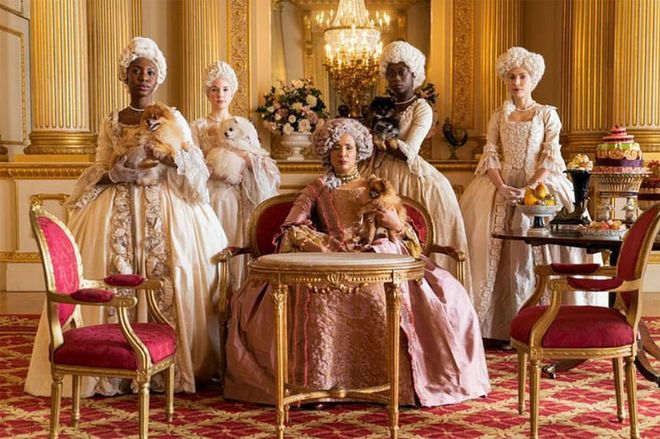What 'Bridgerton' Gets Right About Queen Charlotte, A Real-Life Royal
She did love her Pomeranians and gossip.

The appraising eye of the beehive-adorned Queen Charlotte in Netflix’s Bridgerton and the newly released prequel series is not to be questioned; it is perhaps one of the series’ most simultaneously charming and chilling traits. I would never dare question her. Queen Charlotte’s word is gospel, so when gossip writer Lady Whistledown threatens to undermine her authority with a gospel of her own, the queen responds with a determination that would force even her precious Pomeranians to tuck their tails and run. Yet, at home, we see a gentler, less assured version of the English queen. As her King George descends further into something akin to madness, her ruthless facade wavers. There’s something gentler, even pained, behind all the pomp and circumstance.
Of all the larger-than-life Bridgerton characters, Queen Charlotte’s role pulls the most from reality. The queen was, in fact, a real historical figure, and she might have even been England’s first Black member of the royal family. Actress Golda Rosheuvel, who plays the queen, describes her as “wealthy, dirty rich, addicted to snuff, devoted to her family, loves gossip and she is divinely in love with her husband who is slowly going mad.”
Here’s how that holds up to history.
Related article: ‘Bridgerton’ Is Getting A Prequel Series About Young Queen Charlotte

Photo: LIAM DANIEL/NETFLIX
Queen Charlotte 'Bridgerton'
Queen Charlotte was quite possibly a Black queen.
Although Queen Charlotte’s exact lineage is still debated to this day, some historians believe that she was England’s first Black royal. In particular, as reported in the Washington Post, historian Mario De Valdes y Cocom believes that Charlotte was “directly descended from a Black branch of the Portuguese royal family.” The artist Sir Allan Ramsay, who crafted many of Queen Charlotte’s royal portraits, seemed to accentuate “African features” in her face, Valdes argues. “His representations of her were the most decidedly African of all her portraits,” he wrote for PBS’s Frontline.
Buckingham Palace never denied this possibility; instead, a spokesperson for the palace told the Boston Globe, “This has been rumored for years and years.”
Still, some historians remain skeptical. “The theory does not impress me, but even if it were true, the whole thing would have been so diluted by this stage that it couldn’t matter less to our royal family,” royal historian Hugo Vickers told the Guardian in 2009. “It certainly wouldn’t show that they are significantly Black.”
Related article: Everything We Know About ‘Bridgerton’ Season 3

Photo: Getty
Queen Charlotte
She did love her Pomeranians.
When Queen Charlotte sailed to England to marry the king, she brought with her two Pomeranians named Phoebe and Mercury. Her love for the breed led her to gift Pomeranians to other members of the royal family, and in later decades, her granddaughter Queen Victoria became a famous Pom aficionado herself. She bred the dogs and kept them as near-constant companions, traveling with them and relying on them for comfort after the death of Prince Albert.
Her snuff addiction is documented.
The queen didn’t earn the nickname “Snuffy Charlotte” for nothing. She loved the dry, ground tobacco, and her face was adorned on snuff boxes, which were “as much a definition of status and fashion as the latest mobile phone in the early 21st century,” describes History West Midlands, an independent history site reviewed by academics.
Queen Charlotte had an entire room at Windsor Castle dedicated to her snuff collection, her favorite of which was named Violet Strasbourg, a blend mixed with bitter almonds, ambergris, and attar.
Queen Charlotte and King George III were truly in love.
Although the 17-year-old Charlotte married her husband within only six hours of meeting him, they were fortunate: The relationship was a good one.
Together they had 15 children—a remarkable feat, given infant and maternal mortality rates in the 18th century—and they remained married for nearly 60 years. When they were apart, she wrote him letters, even signing them, “Your very affectionate Friend and Wife Charlotte.” Although it’s likely their relationship suffered when the king grew deeply mentally ill, she never turned her back on him. Until the day she died in 1818, she remained her husband's guardian.
Related article: Phoebe Dynevor Isn’t Returning For Season 3 Of ‘Bridgerton’

Photo: Getty
King George III Consort Charlotte Sophia and family
She did embed herself in London’s social scene.
Queen Charlotte’s judgmental stare was not merely a creation of Rosheuvel’s imagination. The queen was, in fact, deeply involved with gossip around the “ton,” and the first known debutante ball was hosted in her honor. The tradition lasted for decades afterward, up until Queen Elizabeth II canceled the balls in the 1950s.
This article originally appeared on Harper's BAZAAR US.